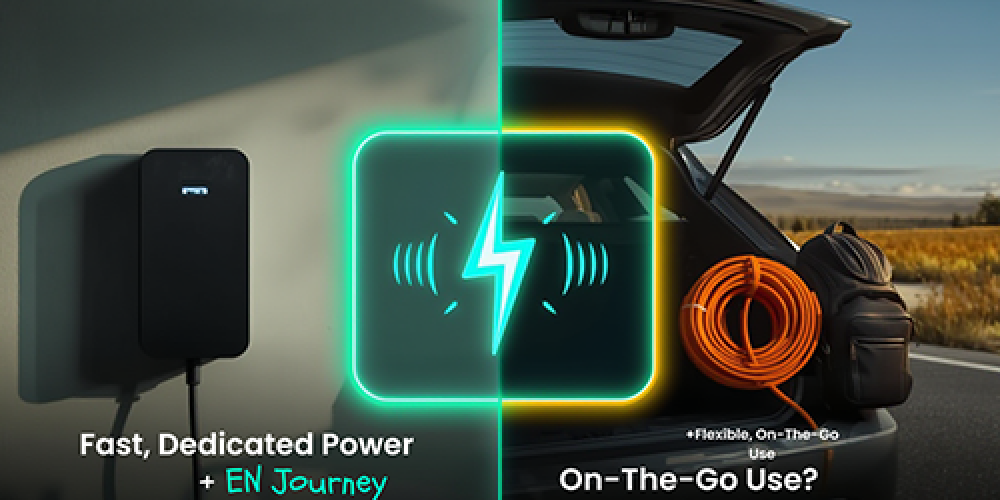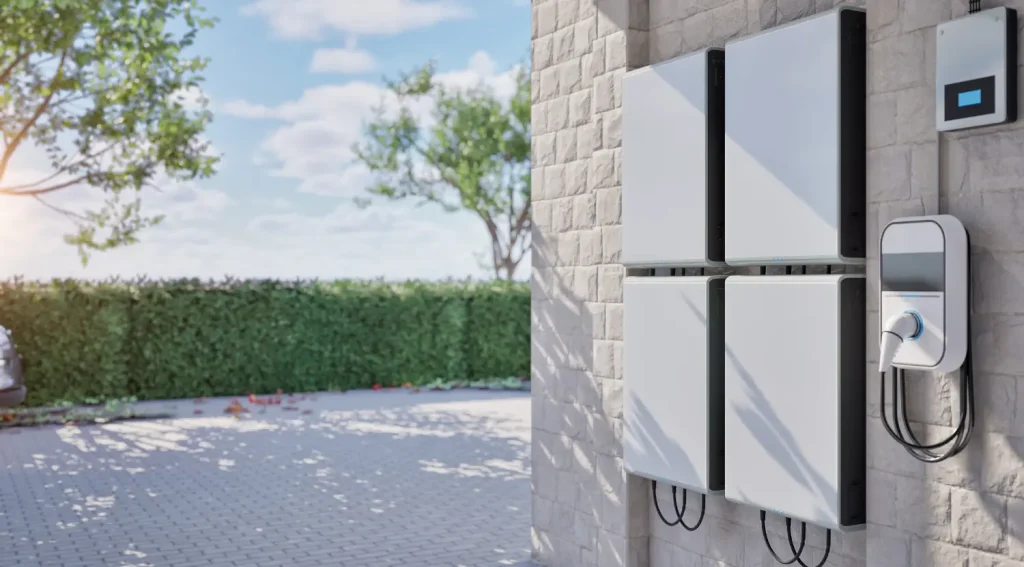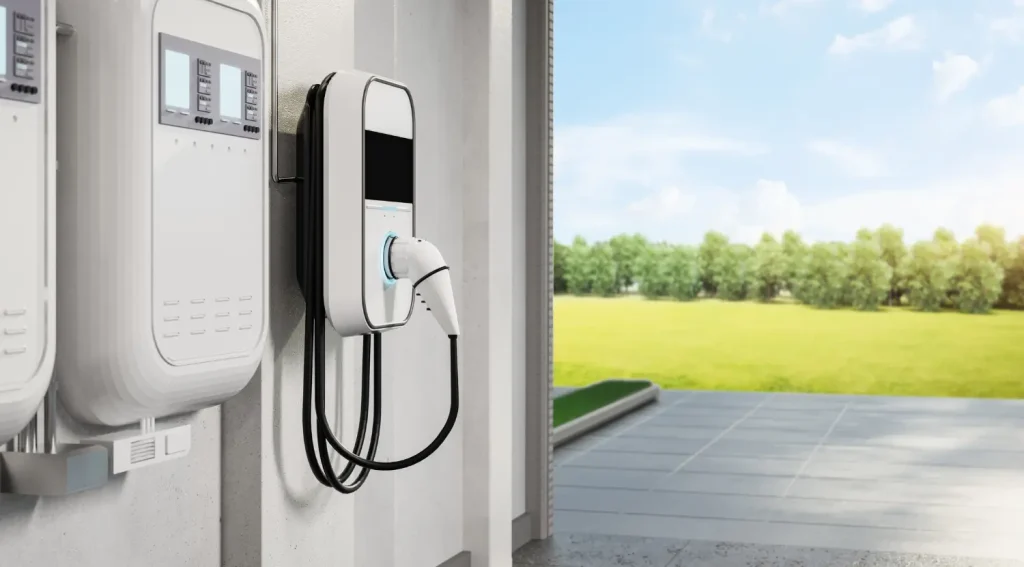
So, you’ve just purchased an EV or perhaps are thinking of buying one? The choice between a portable cord and a wall-mounted box is probably the first big decision you’ll make. One offers freedom; the other offers, well, speed.
We’re here to break down the practical differences to help you figure out which setup is actually right for your garage and your lifestyle.

The Basic Breakdown
Before we dive deep, let’s get the terminology straight. We’re talking about two very different approaches to the same problem.
First up is the Portable EV Charger. This is often the charger that comes included in the trunk of your new EV. Its main job is to plug into a standard 120-volt (120V) wall outlet, the same one your toaster uses. This is known as Level 1 charging. However, many portable chargers (or “mobile connectors” as some brands call them) also come with adapters, allowing them to plug into a 240-volt (240V) outlet—like the one for your clothes dryer. This gives you somewhat faster Level 2 charging speeds, but from a non-permanent device. Honestly, its core identity is flexibility. You can take it with you.
Then, you have the Home EV Charger, also called a wall-mounted charger or an EVSE (Electric Vehicle Supply Equipment). This is a dedicated, professionally installed charging station. It’s a permanent fixture, thus becoming an appliance in your home. This unit connects directly to your home’s electrical panel (or a dedicated circuit, rather) to deliver a much more powerful and stable 240V charge. This is the definitive Level 2 charging experience. Its core identity? Speed and pure convenience. This is your personal, on-demand refueling station.
Portable EV Charger Vs. Home EV Charger (Head-to-Head)

Okay, so they look different. But how do they feel different in day-to-day life? The differences are most obvious in four key areas.
| Feature | Portable EV Charger | Home EV Charger (Wall-Mounted) |
|---|---|---|
| Charging Speed | Slow (Level 1): 3-5 miles/hr. Faster (Level 2): 15-25 miles/hr (if 240V outlet is available). | Very Fast (Level 2): 20-60 miles/hr. Guarantees a full charge overnight. |
| Cost & Installation | Low Cost: Often free with car. Installation: $0 (needs a standard outlet). | High Initial Cost: $600 – $4,000+ for unit & professional installation. |
| Daily Convenience | High Flexibility: Great for renters & travel. Hassle: Must pack/unpack; manual cord management. | Peak Convenience: “Set it and forget it.” Hassle: Permanent fixture; not for renters. |
| Smart Features | Typically “Dumb”: Basic safety cutoffs. No scheduling. | Typically “Smart”: Wi-Fi/App enabled. Allows off-peak scheduling & energy tracking. |
1. The Need for Speed (This is the big one, arguably)
This is not just a small difference; it’s a fundamental gap in experience.
● Portable (Level 1): When plugged into a standard 120V outlet, we’re talking slow. How slow? You can expect to add about 3 to 5 miles of range per hour of charging. Let that sink in. If you have a 60-mile round-trip commute, you’d need 12-20 hours of charging just to get back what you used. For a full battery from empty? You could be waiting days, not hours. It’s barely enough for topping off a short commute or for a plug-in hybrid with a small battery.
● Portable (Level 2 via 240V): Better still. If you have an existing 240V outlet (like a NEMA 14-50, common for dryers or RVs) and an adapter, your portable charger can pull more power. Now we’re in the 15-25 miles of range per hour ballpark. That being said, these portable units themselves often max out at a lower amperage (say, 16 to 32 amps) compared to a dedicated home station, just to be on the safe side.
● Home (Level 2): This is the gold standard for home charging. Period. Because it’s hardwired and built for the job, a home charger can safely deliver much higher power (typically 32, 40, or even 48 amps). This translates to 20-60 miles of range added per hour, depending on the charger’s output and your car’s ability to accept that power.

Let’s use a real-world scenario. You get home at 6 PM with 50 miles of range left. You need to leave for a 150-mile trip at 8 AM the next morning.
● Level 1: You plug in for 14 hours. You’ve perhaps added 56 miles (14 hours x 4 mph). You wake up with ~106 miles. You’re not making it without a stop.
● Level 2 Home: You plug in for 14 hours. Even a modest 32-amp charger adds ~25 mph. You’ve added 350 miles of range. You wake up to a 100% full battery with zero range anxiety. This, right here, is the core of the home charging value proposition.
Related: Understanding The Difference Between Level 1 And Level 2 EV Chargers
2. The Wallet Test: Cost & Installation
This is where the portable charger seems to have a clear win, but it’s a bit more nuanced.
Portable: The unit is often included with the car. On top of that, there’s zero installation cost. You just need an outlet. It’s the undisputed budget champ right out of the box. If you don’t have a 240V outlet handy, you’re stuck at Level 1 speeds, but your installation expense remains $0.

Home: Here’s the catch. A good quality, UL-listed Level 2 home station itself costs several hundred dollars. Then, you need a licensed electrician to install it. This job can run anywhere from $600 to $4,000, or even more. Why the huge range? It depends on your home’s wiring. You might need a new 240V circuit, a long wire run from the panel to your garage, or—in some older homes—a full electrical panel upgrade to handle the load. Having said that, it’s a one-time investment that adds tangible value to your home.
If you don’t want to spend on panel upgrade do check our guide on EV Charger Installation Without A Service Panel Upgrade.
Speaking of cost, don’t forget to check for local utility or even federal incentives for home charger installation. They can soften the financial blow, somewhat.
Related: EV Charging Stations For Condos And Apartments
3. Daily Life & Convenience
How does each option fit into your actual life?
Portable: This is the clear winner for renters. You cannot very well ask your landlord to install a hardwired charger. It’s also great for anyone who moves often. You can just toss it in the trunk for a road trip or visiting family (assuming they have an outlet for you). But, you do have to… you know, remember to pack it. And you might be dealing with coiling up a heavy, sometimes dirty, cord every day. It’s a small hassle, but it’s a daily one.
Home: We’d argue this is the peak of EV convenience for a homeowner. It’s just there. The cable is likely managed by a hook or retractor. You pull in, grab the handle, plug in. It takes 10 seconds. No fiddling with cords in the rain, no “Did I forget the charger?” panic. It becomes an invisible part of your home, like the garage door opener. You just… stop thinking about it.
4. Brains & Safety (Smart Features)
Portable: Most portable chargers are, well, pretty basic. They have the necessary safety cutoffs to prevent overheating or electrical faults, but that’s about it. They’re “dumb” in the sense that they just deliver power.
Home: This is where the tech really shines. Many home chargers are “smart” chargers. What does that mean? It means they connect to your Wi-Fi. They have an app. You can schedule your charging sessions to only run during off-peak electricity hours (e.g., from midnight to 6 AM), which can save you a ton of money, thereby making the charger pay for itself over time. You can track your exact energy use. Better yet, the hardwired connection is seen by many experts (including us) as a more robust, long-term, and safer connection than a high-draw plug-and-outlet setup that could wear out over years of daily use.
The Verdict: Who is Each Charger Really For?

So, which one is it?
A Portable Charger is Probably Your Best Bet If…
● You’re a renter. The inability to modify your home makes this the default choice.
● You drive very little. If your daily commute is, say, under 30 miles, a Level 1 portable charger can actually keep up just fine overnight.
● You have reliable, free, or cheap charging at your workplace or nearby.
● Your budget is the absolute #1 priority and you already have a 240V outlet in a convenient spot. In this case, a Portable Level 2 setup is a great middle ground.
A Home Charger is Well Worth the Investment If…
● You’re a homeowner and plan to stay for a while.
● You have a significant daily commute and need a full battery, every morning, guaranteed.
● You want the “set it and forget it” ease and to eliminate “range anxiety” from your life.
● You want to use smart features to save money on your electric bill.
● Long story short: you want the full, seamless EV ownership experience. Honestly, it’s the solution that makes an EV feel just like a gas car, only you refuel at home for pennies on the dollar.
Our Take…
Feeling some decision fatigue? Honestly, if you ask us, we’d recommend considering both. If you’re a homeowner, investing in a wall-mounted unit is well worth it and will just make your life easier.
Similarly, having a portable charger… you may not need it all the time, but for the peace of mind that you will not get stranded somewhere, it’s a real range-anxiety buster.
And if you don’t own your home, you’re not out of luck. Check out our guide on EV Charging Stations For Condos And Apartments.
Speaking of which, if you’re weighing those options, explore Duevolt’s range of EV Chargers—from portable ones to full-fledged home units.
